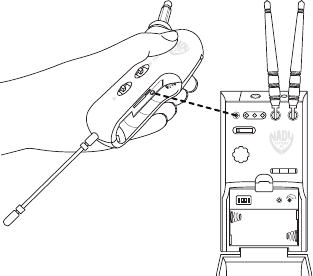
powers the unit and will not charge NiMH
rechargeable batteries if installed. For battery
operation the AC adapter must be disconnected.
Note: For quietest optimal performance, use
the AC/DC adapter as battery operation raises
the noise floor around 4 dB. Generally this is
only a concern when playing high-gain lead
guitar. For such applications, experiment to see
if slightly quieter performance with the AC/DC
supply is preferred.
Turn on the MGT-16 receiver by sliding
the Power Switch (2) to the second position
(receiver On but audio output Muted/
Attenuated), or to the third position for
normal operation (receiver On and audio
un-Muted). The Power LED (12) will light up
and the receiver is operational.
Adjusting the Squelch
The RF Squelch (13) control should be
adjusted counterclockwise to the minimum
RF squelch setting at which the RF Signal
LED (10) remains on while your transmitter is
in normal use, up to the maximum operating
range anticipated in use for your application.
However, in areas of high RF activity, the
squelch control may need to be adjusted
clockwise. If the transmitter is off and the
receiver RF Signal LED indicator is flickering
or stays on continuously, the squelch should
be adjusted to a higher level (clockwise
for less mute sensitivity level) to stop the
flickering. Be careful not to select too high
a clockwise setting as this may reduce the
operating range to below what is needed.
A range walk test will help in selecting
the proper level. If the range is not critical,
note that a clockwise (maximum squelch)
setting will also yield a quieter mute
function, which may be desirable in certain
applications. The squelch level is factory
preset at maximum sensitivity and operating
range (i.e. counterclockwise for minimum
squelch/maximum usable range).
Note: Set controls carefully. If trim-pots are turned
past minimum or maximum adjustment points
they may need to be backed up to achieve
desired setting.
Selecting the MGT-16 Receiver
Channel and IR Sync
The Frequency Select DIP Switches (4)
are used for selecting one of 16 preset
frequencies. Simply position the DIP
switches to a desired open channel on the
receiver. There should be no flickering of
the RF Signal LED (10) with the transmitter
off. See the MGT-16 DIP-Switch Frequency
Selection Chart on page 14 for the correct
switch position for each of the 16 available
channels. Once you have selected
the receiver frequency it can easily be
downloaded to the transmitter to establish
the necessary RF connection. For help in
finding open channels, see RF Interference
and Finding Open Channels on page 12.
The IR Sync Button (14) on the MGT-16 receiver
is used to transfer the selected frequency
info from the receiver to the transmitter for
quick synchronization prior to use. Begin
programming by holding the wireless
transmitter’s IR Receptor/Sensor Window (21)
about 6-12” from the receiver’s IR Synch
Infrared LED Window (1). Press the IR Sync
Button once to begin the IR sync download
of the selected frequency to the transmitter.
Note: To insure proper synchronization, the
transmitter must always be just turned on, or
else turned of then on again before synching.
8
POWER
POWER
ACT
IR PO LO RX
LEVEL
CHANNELSQ
OFFON
6-12”


















